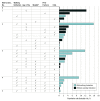Patient Self-Assessment of Walking Ability and Fracture Risk in Older Australian Adults
- PMID: 38261318
- PMCID: PMC10807297
- DOI: 10.1001/jamanetworkopen.2023.52675
Patient Self-Assessment of Walking Ability and Fracture Risk in Older Australian Adults
Erratum in
-
Error in Figure.JAMA Netw Open. 2024 Feb 5;7(2):e242957. doi: 10.1001/jamanetworkopen.2024.2957. JAMA Netw Open. 2024. PMID: 38373002 Free PMC article. No abstract available.
Abstract
Importance: The relationship between self-reported walking limitation, a proxy of muscle function, and fracture risk has not been investigated.
Objective: To examine the association between a self-reported walking limitation of 1000 m or less and 5-year risk of fracture.
Design, setting, and participants: This prospective cohort study compared individuals with various degrees of walking ability limitation at 1000 m (a little limitation and a lot of limitation) and those without limitation (no limitation) accounting for age, falls, prior fractures, and weight. Participants from the ongoing population-based Sax Institute 45 and Up Study were followed from recruitment (2005-2008) for 5 years (2010-2013). Data analysis was conducted from July 2020 to September 2023.
Exposure: Self-reported walking limitation.
Main outcomes and measures: Incident fracture and site-specific fractures (hip, vertebral, and nonhip nonvertebral [NHNV] fractures).
Results: Among the 266 912 participants enrolled in the 45 and Up Study, 238 969 were included, with 126 015 (53%) women (mean [SD] age, 63 [11] years) and 112 954 (47%) men (mean [SD] age, 61 [11] years). Approximately 20% reported a degree of limitation in walking 1000 m or less at baseline (39 324 women [24%]; 23 191 men [21%]). During a mean (SD) follow-up of 4.1 (0.8) years, 7190 women and 4267 men experienced an incident fracture. Compared with participants who reported no walking limitations, a little limitation and a lot of limitation were associated with higher risk of fracture (a little limitation among women: hazard ratio [HR], 1.32; 95% CI, 1.23-1.41; a little limitation among men: HR, 1.46; 95% CI, 1.34-1.60; a lot of limitation among women: HR, 1.60; 95% CI, 1.49-1.71; a lot of limitation among men: HR, 2.03; 95% CI, 1.86-2.22). Approximately 60% of fractures were attributable to walking limitation. The association was significant for hip, vertebral, and NHNV fracture and ranged between a 21% increase to a greater than 219% increase.
Conclusions and relevance: In this cohort study of 238 969 participants, self-reported walking limitations were associated with increased risk of fracture. These findings suggest that walking ability should be sought by clinicians to identify high-risk candidates for further assessment.
Conflict of interest statement
Figures



Similar articles
-
Association of Physical Activity and Fracture Risk Among Postmenopausal Women.JAMA Netw Open. 2019 Oct 2;2(10):e1914084. doi: 10.1001/jamanetworkopen.2019.14084. JAMA Netw Open. 2019. PMID: 31651972 Free PMC article.
-
Population-Wide Impact of Non-Hip Non-Vertebral Fractures on Mortality.J Bone Miner Res. 2017 Sep;32(9):1802-1810. doi: 10.1002/jbmr.3118. Epub 2017 May 15. J Bone Miner Res. 2017. PMID: 28256011 Clinical Trial.
-
Health Perceptions, Multimorbidity, and New Fractures and Mortality Among Patients With a Fracture.JAMA Netw Open. 2024 Apr 1;7(4):e248491. doi: 10.1001/jamanetworkopen.2024.8491. JAMA Netw Open. 2024. PMID: 38656574 Free PMC article.
-
Exercise for improving outcomes after osteoporotic vertebral fracture.Cochrane Database Syst Rev. 2019 Jul 5;7(7):CD008618. doi: 10.1002/14651858.CD008618.pub3. Cochrane Database Syst Rev. 2019. PMID: 31273764 Free PMC article.
-
Screening for the primary prevention of fragility fractures among adults aged 40 years and older in primary care: systematic reviews of the effects and acceptability of screening and treatment, and the accuracy of risk prediction tools.Syst Rev. 2023 Mar 21;12(1):51. doi: 10.1186/s13643-023-02181-w. Syst Rev. 2023. PMID: 36945065 Free PMC article.
Cited by
-
Error in Figure.JAMA Netw Open. 2024 Feb 5;7(2):e242957. doi: 10.1001/jamanetworkopen.2024.2957. JAMA Netw Open. 2024. PMID: 38373002 Free PMC article. No abstract available.
-
Association between walking and hip fracture in women aged 65 and older: 20-year follow-up from the study of osteoporotic fractures.Osteoporos Int. 2025 Jul;36(7):1155-1164. doi: 10.1007/s00198-025-07508-y. Epub 2025 May 7. Osteoporos Int. 2025. PMID: 40332499 Free PMC article.
-
The Impact of Sedentary Behavior and Physical Activity on Bone Health: A Narrative Review from the Rehabilitation Working Group of the International Osteoporosis Foundation.Calcif Tissue Int. 2025 Aug 15;116(1):109. doi: 10.1007/s00223-025-01421-6. Calcif Tissue Int. 2025. PMID: 40815408 Review.
References
Publication types
MeSH terms
LinkOut - more resources
Full Text Sources
Medical

